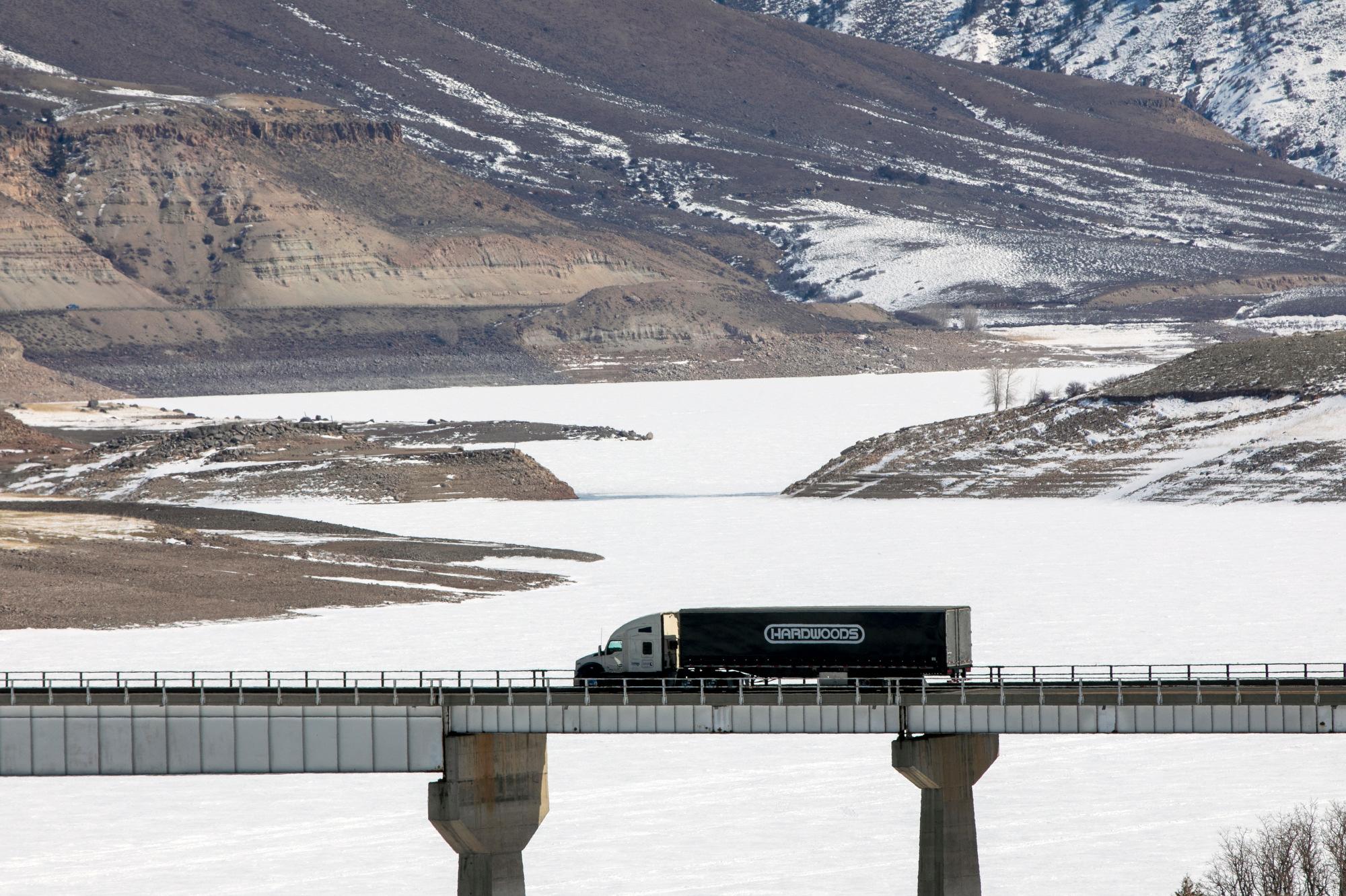
With winter driving conditions already occurring in Colorado's high country, you might get a bit freaked out driving the state's many mountain passes when snow falls.
But professional drivers get white-knuckled, too, according to trucker Finn Murphy of Boulder. His first book, "The Long Haul: A Truckers Tale of Life on the Road," explores life from the seat of his big rig. It opens with a harrowing drive on Loveland Pass.
He spoke with Colorado Matters host Nathan Heffel
Read an excerpt:
Loveland Pass, Colorado, on U.S. Route 6 summits at 11,991 feet. That’s where I’m headed, having decided to skip the congestion at the Eisenhower Tunnel. Going up a steep grade is never as bad as going down. At the top of the pass, high up in my Freightliner Columbia tractor pulling a spanking-new, fully loaded custom moving van, I reckon I can say I’m at an even 12,000 feet. When I look down, the world disappears into a miasma of fog and wind and snow, even though it’s July. The road signs are clear enough, though—the first one says RUNAWAY TRUCK RAMP 1.5 MILES. Next one: SPEED LIMIT 35 MPH FOR VEHICLES WITH GROSS WEIGHT OVER 26,000 LBS. Next one: ARE YOUR BRAKES COOL AND ADJUSTED? Next one: ALL COMMERCIAL VEHICLES ARE REQUIRED TO CARRY CHAINS SEPTEMBER 1 - MAY 31. I run through the checklist in my mind. Let’s see: 1.5 miles to the runaway ramp is too far to do me any good if the worst happens, and 35 miles per hour sounds really fast. My brakes are cool, but adjusted? I hope so, but no mechanic signs off on brake adjustments in these litigious days. Chains? I have chains in my equipment compartment but they won’t save my life sitting where they are. Besides, I figure the bad weather will last for only the first thousand feet. The practical aspects of putting on chains in a snowstorm, with no pullover spot, in pitch dark, at 12,000 feet, in a gale, and wearing only a T-shirt, is a prospect Dante never considered in enumerating his circles of hell. The other option is to keep rolling -- maybe I’ll be crushed by my truck at the bottom of a scree field, maybe I won’t. I roll. I can feel the sweat running down my arms, can feel my hands shaking, can taste the bile rising in my throat from the greasy burger I ate at the Idaho Springs Carl’s Jr. (It was the only place with truck parking.) I’ve got 8.6 miles of 6.7 percent downhill grade ahead of me that has taken more trucks and lives than I care to think about. The road surface is a mix of rain, slush, and (probably) ice. I’m one blown air hose away from oblivion, but I’m not ready to peg out in a ball of flame or take out a family in a four-wheeler coming to the Rocky Mountains to see the sights. I downshift my thirteen-speed transmission to fifth gear, slow to 23 mph, and set my Jake brake to all six cylinders. A Jake brake is an air-compression inhibitor that turns my engine into the primary braking system. It sounds like a machine gun beneath my feet as it works to keep 70,000 pounds of steel and rubber under control. I watch the tachometer, which tells me my engine speed, and when it redlines at 2,200 rpm I’m at 28 mph. I brush the brakes to bring back her down to 23. If it’s going to happen, it’s going to happen now. My tender touch might cause the heavy trailer to slide away and I’ll be able to read the logo in reverse legend from my mirrors. It’s called a jackknife. Once it starts, you can’t stop it. In a jackknife the trailer comes all the way around, takes both lanes, and crushes against the cab until the whole thing comes to a crashing stop at the bottom of the abyss or against the granite side of the Rockies. It doesn’t happen, this time, but the weather is getting worse. I hit 28 again, caress the brake back down to 23, and start the sequence again. Fondle the brake, watch the mirrors, feel the machine, check the tach, listen to the Jake, and watch the air pressure. The air gauge read 120 psi at the summit; now it reads 80. At 60 an alarm will go off, and at 40 the brakes will automatically lock or just give up. Never mind that now just don’t go past 28, and keep coaxing her back down to 23. I’ll do this twenty or thirty times over the next half an hour, never knowing if the trailer will hit a bit of ice, the air compressor will give up, the Jake will disengage, or someone will slam on the brakes in front of me. My destination is the ultra-rich haven called Aspen, Colorado. This makes perfect sense because I’m a long-haul mover at the pinnacle of the game, a specialist. I can make $250,000 a year doing what is called high-end executive relocation. No U-Hauls for me, thank you very much. I’ll take the movie stars, the ambassadors, and corporate bigwigs. At the office in Connecticut they call me the Great White Mover. This Aspen load, insured for $3 million, belongs to a former investment banker from a former investment bank who apparently escaped the toppling citadel with his personal loot intact. My cargo consists of a dozen or so crated modern art canvases, eight 600-pound granite gravestones of Qing Dynasty emperors, half a dozen king-size pillow-top beds I’ll never figure out how to assemble, and an assortment of Edwardian antiques. The man I’m moving, known in the trade as the shipper, has purchased a $25 million starter castle in a hypersecure Aspen subdivision. He figures, no doubt accurately, he’ll be safe behind the security booth from impecunious widows and mendacious foreign creditors. I’m looking downhill for brake lights. I can probably slow down, but there’s no chance of coming to a quick stop. If I slam on the brakes I’ll either crash through the vehicle in front of me or go over the side. I want to smoke a cigarette, but I’m so wound up I could never light it, so I bite off what’s left of my fingernails. I’m fifty-eight years old, and I’ve been doing this off and on since the late 1970s. I’ve seen too many trucks mashed on the side of the road, too many accidents, and too many spaced out-drivers. On Interstate 80 in Wyoming I watched a truck in front of me get blown over onto its side in a windstorm. He must have been empty. On I-10 in Arizona I saw a state trooper open the driver door of a car and witnessed a river of blood pour out onto the road. The blood soaking into the pavement could be mine at any moment. All it takes is an instant of bad luck, inattention, a poor decision, or equipment failure -- or, most likely, someone else’s mistake. If that happens, I’m a dead man. Edited excerpt from The Long Haul by Finn Murphy with permission of W.W. Norton & Co. NY, NY. Copyright (c) Finn Murphy 2017. |









